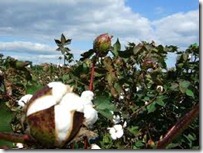 More than 99 percent of Texas was in one level of drought or another by the last week of July, according to the U.S. Drought Monitor.
More than 99 percent of Texas was in one level of drought or another by the last week of July, according to the U.S. Drought Monitor.
More than 90 percent of the state was in an extreme drought; 75 percent in an exceptional drought, according to the monitor. Daytime high temperatures continued to challenge or beat historical records in many parts of the state.
Throughout the state, except small pockets where there has been rain, producers continued to struggle with dropping irrigation well and stock-water tank levels, desiccated pastures and hay shortages, according to reports from Texas AgriLife Extension Service personnel.
"Different week, same song," said Rick Auckerman, AgriLife Extension agent for Deaf Smith County, west of Amarillo. "Producers are trying to run water on as many crops as possible, but the cotton is needing more water now also. The corn crop is in dire need of water, and many producers are abandoning parts or whole fields of corn production in hopes to salvage what they can."
"What small amount of cotton that is left in the county is under irrigation, but farmers are beginning to turn the water off due to the amount of money they already have in the crop. They are worried they may not get that back in the market," said Ryan Martin, AgriLife Extension agent for Motley County, east of Lubbock. "Some of the cotton under irrigation looks very good, but once out in it, farmers realize it’s just not putting on the fruit like it should be."
"All range and pastures are in extremely bad condition," said Lyle Zoeller, AgriLife Extension agent for Coryell County, west of Waco. "All classes of livestock were being fed heavily. Many cows are going to local market, as well as most calves 300 pounds and over. There is no hay available in the area; most is coming from out of state. Low-water sources are now forcing sales of cattle."
More information on the current Texas drought and wildfire alerts can be found on the AgriLife Extension Agricultural Drought Task Force website athttp://agrilife.tamu.edu/drought/.
AgriLife Extension district reporters compiled the following summaries:
North: No rain and temperatures 100 degrees and above took a toll on pastures and hay meadows. Corn that was not cut for silage was yielding 40 to 70 bushels per acre. Some grain sorghum was harvested, but yield reports weren’t in. About 95 percent of grain sorghum was being baled as hay. Early planted soybeans were expected to yield 10 to 12 bushels per acre. Later planted soybeans were either harvested for hay or plowed under. With no relief from the heat in sight or any rain forecast, there was not any further forage production expected. Limited supplies of hay were fast dwindling and quickly sold. Livestock were suffering. Water for livestock was becoming a major concern as stock-ponds levels dropped. Producers continued to sell livestock. The Van Zandt County Auction sold 900 head on a July 23, high for single day in July. Cotton was in poor to fair condition. Reports noted an increase in grasshopper and feral hog activity.
Rolling Plains: The region remained extremely dry and hot. With daytime temperatures above 110 degrees, the National Weather Service issued and excessive heat warning. All grasses and trees were in jeopardy in rural and urban areas. Additional water restrictions were expected, which will add to landscape losses. Ranchers were continually shipping cull cows and calves in an effort to reduce pressure on what small amount of grazing was left. Pastures were grazed down, and ranchers were running out of money to buy supplemental feeds as they have been feeding since before winter. Some ranchers were shipping cattle north trying to hold on to them for when it does start to rain. Others were forced to entirely sell out due to lack of grazing. Some livestock producers worried if they sell off now, they may not be able to get back into the cattle business if replacement prices skyrocket after the drought ends. Farmers were in the same condition as most row crops were "disastered-out" for crop insurance. Stock-water tank levels continued to drop. There were also fish die-offs in urban lakes because of low water levels and oxygen depletion. Burn bans remained in effect.
http://www.timesrecordnews.com/news/2011/aug/06/crop_report-8-6/

Deprecated: strpos(): Passing null to parameter #1 ($haystack) of type string is deprecated in /home/agriviek8Qv/agriviet.net/public_html/wp-includes/comment-template.php on line 2522